
24 minute read
Prof Jonathan Jansen on education
LEADERSHIP, IMAGINATION
AND PARTNERSHIP The future looks bleak The Minister of Finance in his medium-term institutions; for the most part, teaching and even be used as a revenue stream by expenditure budget just announced a R1-billion cut for higher education and The arrival of COVID-19 forced the country’s education landscape training. And the private sector is highly to undergo a rapid transformation. Professor Jonathan Jansen unlikely to invest money in building technological infrastructures from scratch looks at what this means for the future of universities in the poorer universities. The digital divide between the top 13
The most important impact of Our default reaction in an get worse. But is UNISA not the answer? COVID-19 on universities has been the re-organisation of the teaching and learning interface; in other words, the education crisis is to play catch-up and, when the chips With more than 400 000 students, the largest South African university has seen its administrative and technological educational space has been forced to are down, to blame the past’s infrastructures all but collapse even as a change. This is a good thing. Our traditional universities are conserving historical injustices. high-level panel investigates the demise of this once proud institution. learning still happens as it did a century ago we need imagination when South African universities came into time we could not look away. The established, In the end, the primary challenge faced by existence as colleges. Yes, there have been mainly former white universities, transitioned our universities is not aggregate resources, innovations on the margins such as massive smoothly to remote and fully online learning but the educational imagination. Our default open online courses (MOOCs), but as the while the historically black universities reaction in an education crisis is to play president of a famous university in the Silicon found themselves stranded with hopelessly catch-up and, when the chips are down, to Valley once confided, “the only problem with inadequate technological infrastructures for blame the past’s historical injustices. these MOOCs is massive and open”. Students teaching students at distance in the deep We do not have a parallel stream of inventors want face-to-face teaching and lecturers are rural Eastern Cape or the border regions of and innovators who look to the future and ask comfortable with traditional lecture routines. Limpopo province. compelling and daring new questions. How do A seldom-told perverse tale is that the we turn those empty campus residences into Then came COVID-19 more privileged universities had scaled up technology hotspots for future shutdowns? What we observed for schools was also true their investments in technologies for teaching What new partnerships can be forged between for universities: the already-present digital and learning when the first ‘v’ (violence) government, universities and the private sector divide became even more obvious, but this threatened the academic year, shutting (all three will need to be involved to make this down institutions during the historic 2015–16 work) to make available data, devices and campus protests. When the second ‘v’ (virus) connections for teaching and learning at a came along, these well-resourced universities distance? Can South Africa be the locale for were prepared to switch from one mode of cutting-edge technologies that address the teaching and learning to the next. unresolved challenges of online learning in What is also less well known is that the professional fields such as diagnoses in clinical black universities sat with massive new medicine and the supervision of the teaching infrastructures that became white elephants practicum in schools? overnight. Over the past five years alone, We can think our way out of these the Department of Higher Education and challenges through deliberative planning and Training invested a staggering amount of over cross-sectoral investments in next-generation R11-billion on residential infrastructure on technologies that support the new face of university campuses. With the lockdown, education provision in a post-COVID-19 world. these facilities stood empty of students for The only other thing missing is leadership to much of the academic year and could not take this forward. and the bottom 13 universities will surely outside communities during university *Jonathan Jansen is Distinguished Professor holiday periods. of Education at Stellenbosch University.
The historically black universities found themselves stranded with hopelessly inadequate technological infrastructures for teaching students at distance.
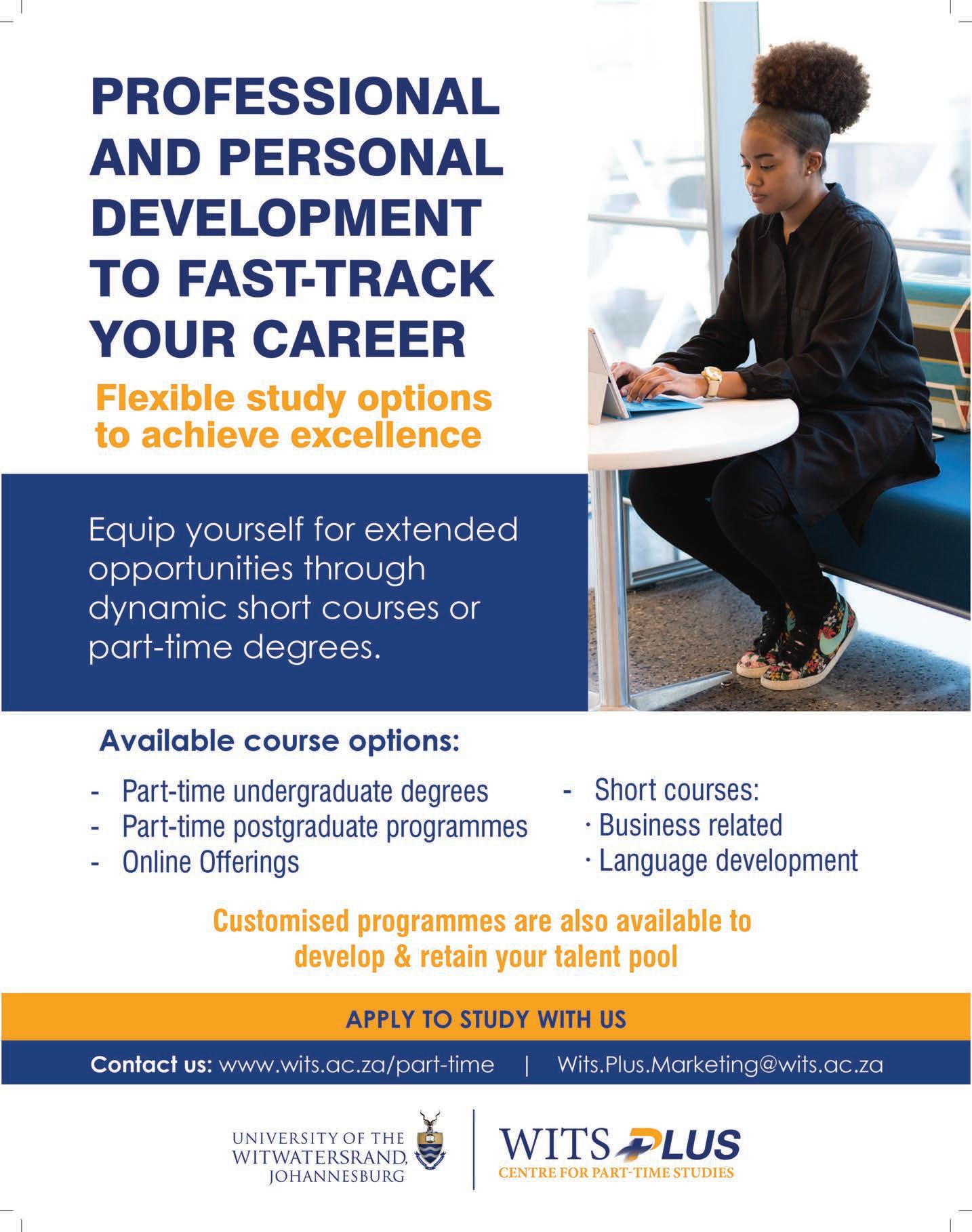
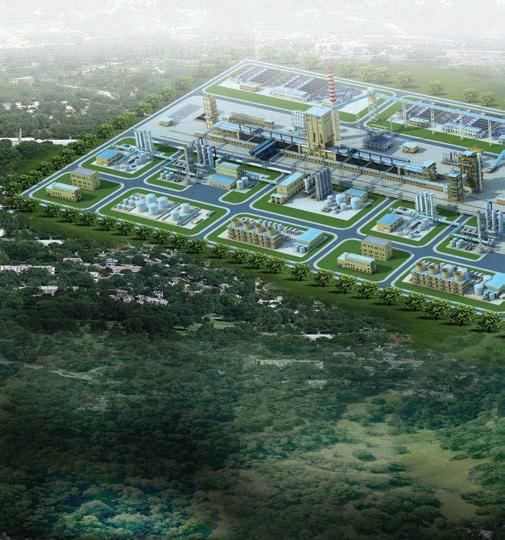
Th e Musina‐Makhado Special Economic Zone will off er investment opportunities and job creation
The Musina-Makhado Special Economic Zone (MMSEZ) is located close to the main land-based route into SADC and the continent. This, together with supporting incentives and a good logistics backbone, makes it the location of choice for investment in the mineral benefi ciation, agroprocessing, manufacturing and logistics industries. The establishment of the metallurgical cluster near the source of raw materials, along with a logistics hub with access to markets, will present unique opportunities for mineral benefi ciation – a key priority for national government. MMSEZ will also provide job opportunities for the people of Limpopo.
Following the enactment of the Special Economic Zones Act, the Limpopo provincial government submitted a comprehensive proposal on strategic areas to develop the province’s economy through industrialisation to the Department of Trade Industry and Competition (dtic). The dtic designated the MMSEZ, which has become the fl agship of the provincial government. Subsequently, the Musina-Makhado state-owned company (SOC), a subsidiary of the Limpopo Economic Development Agency, was established. It is tasked with the responsibility of facilitating, planning and developing the MMSEZ.
MMSEZ BUSINESS CASE
A new industrial hub in the Vhembe District Municipality, part of the Trans-Limpopo Spatial Development Initiative, is behind the formation of the MMSEZ. The hub is situated at Makhado and Musina, with each area having its own industrial focus.
The energy and metallurgical cluster (power plant, steel plant, stainless steel plant, coking plant, pig iron plant, ferromanganese plant, ferrochrome plant, chrome plant, lime plant, silicon-manganese and calcium carbide
Artistic Impression of MMSEZ Coking Plant
Lehlogonolo Masoga, CEO, MMSEZ


plants and vanadium-titanium magnetite plant) is located on the Makhado side while the Northern Site in Musina focuses on general manufacturing, agroprocessing and logistics.
The MMSEZ SOC is further responsible for attracting and mobilising domestic and foreign direct investment in the identifi ed industrial activities across the value chain. The North-South Corridor makes the Musina-Makhado location a strategic passage for trade between South Africa, the SADC region and the African continent in line with the Africa Continental Free Trade Agreement. Limpopo has always enjoyed being a gateaway to the rest of the continent and home to one of the busiest ports of entry, Beit Bridge border post.
AGROPROCESSING POTENTIAL
The Vhembe region is endowed with various agricultural resources sought after in lucrative world markets, providing potential for agroprocessed products for domestic and international consumption. Food production has become a multibillion dollar industry. Besides agroprocessing there are various other opportunities in the cluster such as food processing, fresh produce handling, dry fruits packaging, food canning, timber processing and furniture manufacturing.
MANUFACTURING WITHIN THE AUTOMOTIVE SECTOR
Over 10 per cent of the automotive vehicles manufactured in South Africa are supplied by road via Beit Bridge to the up-north markets in SADC, making the MMSEZ an ideal location for opportunities across the automotive sector value chain such as vehicle and component manufacturing, storage and distribution hub, after-care products distribution hub and tyre manufacturing distribution hub. The manufacturing cluster of the MMSEZ will provide a platform for various original equipment manufacturers to manufacture products for both domestic and export markets.
SUSTAINABLE DEVELOPMENT
The South African Constitution enjoins us to pursue economic development in a sustainable manner and preserve the environment for the benefi t of current and future generations. The National Environmental Management Act provides that any negative impact on the environment and people’s environmental rights must be anticipated and prevented, and where they cannot be altogether prevented, are minimised and remedied.
Catalytic projects such as the envisaged high-speed rail project will add impetus to the creation of a new smart city based on the principles of smart economy, smart mobility, smart housing, smart environment, smart governance, artificial intelligence and the internet of things.
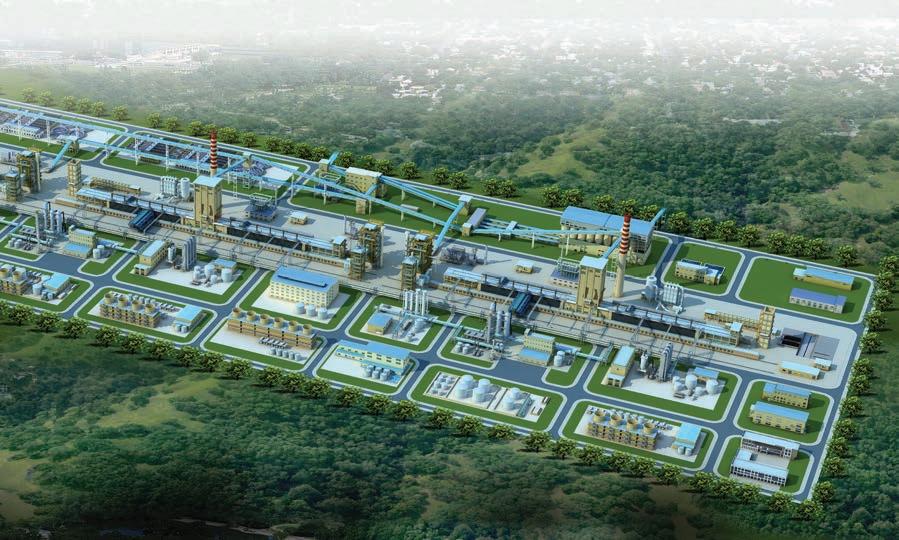
Accordingly, MMSEZ’s application for the environmental impact assessment (EIA) was guided by these values, principles, directives and the entity’s own Environmental, Social and Governance Policy provisions.
Even though September and October 2020 were dedicated to public consultation processes for the EIA application for the South site, the Limpopo Department of Economic Development Environment and Tourism has acceded to the request for further consultations, and accordingly, additional sessions will be held in January 2021.
Thus far, the outcome of the EIA process indicates that the benefits of the MMSEZ will potentially promote justifiable economic and social development with an inevitable negative impact on the environment. The goal of the EIA process is to ensure the protection of ecologically-sensitive areas and support sustainable development and the use of natural resources while promoting justifiable socioeconomic development. The MMSEZ has also developed an environmental management plan to provide mitigation measures to ensure that the project is planned, constructed, operated, and decommissioned in an environmentally-responsible manner.
THE FAR NORTH REGION’S WATER CHALLENGE
Vhembe District is an arid region with low rainfall and water scarcity, despite bordering one of the biggest rivers on the continent, Limpopo River. Mindful of this situation, the MMSEZ SOC has commissioned studies to explore potential sources of water to guarantee security of supply for the project. Among the potential long-term water supply solutions is a cross-border water transfer scheme with the possibility to yield over 200 million cubic metres of water and the prospect of developing a new mega Musina Dam.
Discussions are at an advanced stage between South Africa and Zimbabwe for the sharing of possible excess water resources. Working in partnership with the Department of Water and Sanitation and the Vhembe District Municipality, the MMSEZ SOC is currently conducting a feasibility study to investigate the proposed engineering model for harvesting the runaway floodwater from the Limpopo River.
INTEGRATING SMMES WITHIN THE SPECIAL ECONOMIC ZONE
Special economic zones (SEZs) are predisposed to attracting direct foreign investment, which could translate into blue-chip international enterprises locating in the zone, presenting a strategic opportunities for SMMES to partner with big businesses and receive skills and technology transfer. The integration of SMMES forms an integral part of the business model of SEZs. Likewise, in the MMSEZ, the promotion of SMMEs and integration is inherent within the SOC’s business model.
The MMSEZ has developed an enterprise development strategy to mainstream SMMEs development in the life cycle of the project. This will be supported by an SMME incubation centre for entrepreneurship excellence, creativity, skills and technology localisation. This initiative is in partnership with the Department of Small Business Development and De Beers’ Venetia Mine. In October 2020, MMSEZ concluded a Memorandum of Agreement with the CSIR to support SMMEs in the MMSEZ and ensure technology localisation.
DEVELOPING SMALL TOWNS INTO CITIES
The MMSEZ is expected to transform the spatial configuration of Musina and Makhado. According to the external master plan report, the two towns require an investment of R133-billion in roads, rail, human settlement, schools, health facilities, ICT infrastructure, airport, electricity, water and sewerage.
Catalytic projects such as the envisaged high-speed rail project between Pretoria and Musina will add impetus to the creation of a new smart city based on the principles of smart economy, smart mobility, smart housing, smart environment, smart governance, artificial intelligence and the internet of things.
INVESTMENT OPPORTUNITIES OUTSIDE THE ZONE
SEZ projects stimulate growth and development outside their delimited geographic space. In Musina and Makhado towns, various stimulus packages have been identified as investment opportunities for the private sector outside the confinement of the SEZ spaces. Among such opportunities are the new Musina Dam, high-speed rail project, Manaledzi mega housing project in Makhado, Musina airport, the MMSEZ human settlement, private hospital, private schools and training centres, retail property and hotels. MMSEZ CEO Lehlogonolo Masoga explains that it is for this reason that the MMSEZ offers “a world of
For more information: Mr Richard Zitha
Executive: Investment Promotion R.Zitha@mmsez.co.za +27 (71) 391-8188
Mr Shavana Mushwana
Manager: Marketing and Communication S.Mushwana@mmsez.co.za +27 66 173 8957
www.mmsez.co.za

RENEWED FOCUS ON NDP IMPLEMENTATION IS NEEDED
The National Planning Commission says that COVID-19 is a wake-up call and requires better and focused implementation of the National Development Plan
The second National Planning Commission (NPC), appointed in September 2015 for a five-year tenure, has embarked on a campaign to accelerate the implementation of the National Development Plan (NDP) and has identified pathways to stimulate this.
The COVID-19 pandemic exposed the fissures of poverty, unemployment and inequality in South African society, and these require urgent attention. As the term of the second NPC was extended to March 2021, the NPC has taken advantage of this to engage with the public on the implementation of the NDP.
The NPC will not only highlight the work it has done, but will also get society to play its role in the implementation of the NDP. The pathways, listed below, help society to integrate within the implementation.
PATHWAYS
• building state capacity towards a developmental state • improving the quality of life for all • activating citizen participation in the implementation of the NDP • service delivery through a District Delivery Model (DDM) • building an inclusive economy. Deputy chairperson of the NPC Professor Malegapuru Makgoba stresses that “the NDP is a national lodestar and not merely a government strategy. Society must play its role in the implementation of the NDP”.
Over the past five years, the NPC’s mandate focused on deepening the development of national planning priorities within government and various sectors of society, analysing implementation and resource allocation to NDP priorities, and highlighting advances, gaps and blockages. The NPC has produced more than 30 research outputs including position papers with specific focus on inclusive economy, enhancing the quality of life, and leadership and state capacity.
In the aftermath of COVID-19, the nation agrees that the pandemic has worsened South Africa’s crises of poverty, unemployment, and inequalities. COVID-19 is a set-back to the progress made to improve living standards over the past 26 years. This reality, the NPC asserts, is a sobering wake-up call, a reaffirmation of the NDP, which requires refocusing government and the nation on the plan’s goals and priorities with a strong commitment to implement these better.
OVERALL PERFORMANCE
In February 2020, just before the COVID-19 outbreak, the NPC completed a review of the implementation of the NDP since its adoption eight years ago. The review considered overall performance on NDP goals, and in particular on poverty, inequality and unemployment.
There was substantial progress from 2006 to 2011 in terms of poverty reduction, which fell from 51 per cent of the population to 36.4 per cent. But, income poverty rose to 40 per cent by 2016. Unemployment has increased, and is currently at 30.1 per cent (Q1 of 2020, QLFS), and is more acute for youth. Inequality has remained stubbornly high with a Gini coefficient of 0.65. The majority of the population are not participating fully or equitably in the economic mainstream because of the continuing discriminatory structure of the economy. The economic, social and spatial legacy of apartheid continues to undermine both South Africa’s competitiveness and the potential and capabilities of its people, depriving the country of the skills it needs, and resulting in low growth, low productivity, and hence high unemployment and inequality.
A major achievement is the roll-out of social protection for poor and vulnerable citizens and communities, supported by fiscal policy. This is done through, for example, social grants, delivery of basic services, health and education. However, service quality and reliability need improvement and fiscal constraints now pose a threat to the progress achieved.

Since 2012, the economy barely grew; job creation has been insufficient, investment inadequate and infrastructure constrained. The economy has since been declared junk.
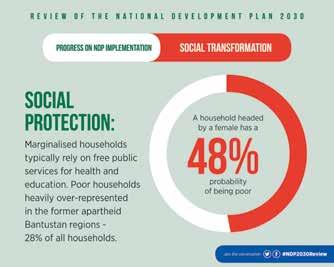
At the same time, the domestic political environment deteriorated, including governance within the state as well as institutional instability and the erosion of citizens’ confidence in the state.

These circumstances proved unconducive for implementation of the NDP. The plan envisaged a paradigm shift in implementation, including the following key prerequisites for success, among others: • focused leadership • the NDP as a plan for all, not just government • a capable and developmental state, able to transform the economy and society to prioritise execute and to mobilise required resources • agreement on trade-offs as well as a social compact. These shifts did not fully materialise. Instead, the challenges faced by the NDP include political contestation; blurring of lines between political and administrative functions; the weakening of government’s institutions, in particular, state-owned enterprises (SOEs); and deepening fiscal constraints. Social partners have not played a strong role in promoting and implementing the plan.
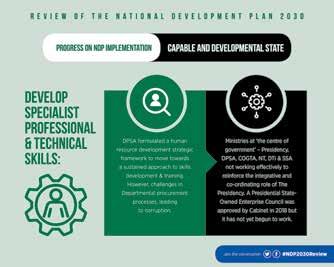
COURSE CORRECTION NEEDED
The NPC has thus concluded that, unless drastic and urgent measures are taken, the country is not on course to achieve the NDP’s 2030 goals, particularly regarding unemployment, poverty, inequality, and inclusive growth. Most concerning is the risk of erosion of the gains South Africa has made since 1994.
The Commission believes that, as South Africa’s lodestar, the NDP is a living document, adaptable to emerging challenges, such as the impact of COVID-19 and the lockdown on the country’s long-term prospects.
The NDP Review calls for urgent course correction to get the country back on the trajectory to 2030 as envisaged by the plan, and, most importantly, better implementation over the next 10 years to 2030. Specifically, the following is recommended:
COVID-19 must serve to concentrate minds, and from the crisis must emerge strong, collective leadership and united action by all actors and society. The prompt emergence of social solidarity and social compacting initiatives responding to the pandemic is encouraging and must be sustained and deepened. These will provide a breath of fresh air that will reinvigorate our democracy and our shared patriotism. They should be harnessed for coherent and co-ordinated multistakeholder actions for a better life for all, and, ultimately, for social cohesion, unity and peace in the country.
The NPC, therefore, welcomes the Reconstruction and Recovery Plan initiated by government and supported by all parties at NEDLAC. This initiative should be the spearhead of reinvigorating implementation of the NDP, based on strong, committed leadership, broad-based ownership – especially by critical stakeholders –accountability and better implementation going forward.
In the spirit of the NDP, the NPC is open to practical and effective partnerships to create a virtuous cycle of development – to achieve the goals of the NDP 2030. These strategic partnerships will assist to revitalise economic growth and make real inroads in education and skills development as an enabler of quality jobs and economic inclusion.
Below is the list of future NPC engagements.
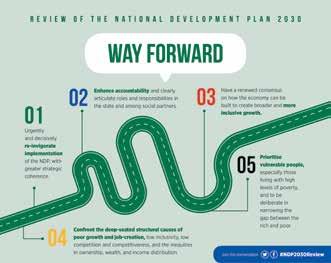
Topic Leading Commissioners Date
Presentation to FOSAD
Township and Rural economies Anti-Racism Roundtable Commissioners Karaan, Taylor, Dooms and Landman Dr Thami Mazwai 7 December 2020
8 December 2020 Mr Jabulani Sithole 9 December 2020
Social Protection Floor and Pathways to a Basic Income Grant post Covid-19 Prof Vivienne Taylor 10 December 2020
Economic Revival Post Covid19 - The core imperatives Dr Miriam Altman 21 January 2021 Restructuring the economy – A case study on the impact of high levels of concentration Roundtable on the NPC Gender Review Mr Elias Masilela 28 January 2021
Prof Vivienne Taylor 4 Fabruary 2021
South Africa as a capable state – the way forward Dr Molokwane and Ms Sue Bannister
Youth Labour Transitions Ms Tessa Dooms 11 Fabruary 2021
18 Fabruary 2021
For inquiries on the webinars and for interaction with the NPC, please phone the NPC secretariat through Dr Mthokozisi Tshuma on 0848654002 and Sandisiwe Mapine on 0713701048.
A TRANSFORMED LEADERSHIP
The role of women in South African society has never been more valued. Since 1994, government and the private sector have been working on policies to pave the way for women to become empowered and take up leadership roles traditionally reserved for men.
EQUITY AND FAIRNESS
In South Africa, there has been both increased legislative protection for consumers and additional avenues for them to register complaints against companies or entities that they feel have wronged them. The Ombudsman for Banking Services (OBS) has, for the past 20 years, been a leader in this fi eld of dispute resolution. Experienced lawyer Reana Steyn who has headed up this offi ce for the past three years believes it is very important that women play an increasingly infl uential role within these bodies. Women are beginning to lead the change they’ve so long fought for. Reana Steyn shares how the banking ombudsman leadership team is refl ective of a more gender balanced environment

Steyn spent nine years at an international fi rm, specialising in matters as diverse as aviation and medical negligence. This was followed by a further decade specialising in insurance law. Her introduction to the credit and regulatory space came with the passing of the National Credit Act Regulations in 2006. Four years later, she began her work in the ombudsman sphere.
EMPATHY AND KINDNESS
Steyn points out that in a democracy with a history like ours, it is important to recognise that complaining and knowing your rights as a bank customer is not always as easy and accessible as people think. “Many consumers need assistance when it comes to the complaints process. Without our help, they can feel overwhelmed and intimidated. “It’s a privilege and an honour to be the fi rst woman to hold the reins in this ombudsman’s offi ce,” says Steyn. “In a world traditionally dominated by men, my appointment was a bold move. I see it as a positive sign of transformation in both the organisation and the wider banking industry. It is also a source of hope for the future.


Reana Steyn, CEO and Ombudsman
“The complaint process is a stressful time for consumers who may feel that large corporations are bullying them. Emotions often run high and an empathetic approach is indispensable during this time. This is especially true when the consumer has lost money due to fraud. It takes special skills to calm emotions and objectively analyse the facts. We have found that women provide a soft touch that is benefi cial in these situations,” says Steyn.
Women make up 62 per cent of the total staff complement at the OBS. In management positions, the ratio is four to two in favour of women. Even the independent board of executives at the OBS has a two to three ratio that favours females.

CELEBRATE STRONG WOMEN
Steyn stresses that it is important that the role of women within corporate leadership roles is not only acknowledged more, but also celebrated.
At the 2020 OBS Awards, a new award was introduced by the OBS, and presented to a well-deserving designated offi cer, Priya Rajah from FNB, who heads the bank’s dispute resolution department. Both the long-standing awards for an employee of a bank’s dispute department who excelled in service delivery and fairness went to females: Karen Jonker from ABSA Bank and Aimee Capuzzimati from Investec were recognised for their outstanding service.
“I was fortunate enough to have strong female role models: women like my grandmother, mother and mother-in-law, who although they did not have the privilege of further education made a great success of their chosen careers through their intelligence, skills and sheer determination. They built a foundation for the next generation, but were not able to achieve the equal status they deserved. Now, things have changed. I believe that by empowering women, we can transform both the modern workplace and society,” says Steyn.
“South Africa is redefi ning the meaning of power and what it means to be a leader. In the process, we are making our society more inclusive, compassionate and fl exible, but still focused on success,” says Steyn.
For more information:
+27 860 800 900 34 Fricker Road Illovo, Sandton www.obssa.co.za



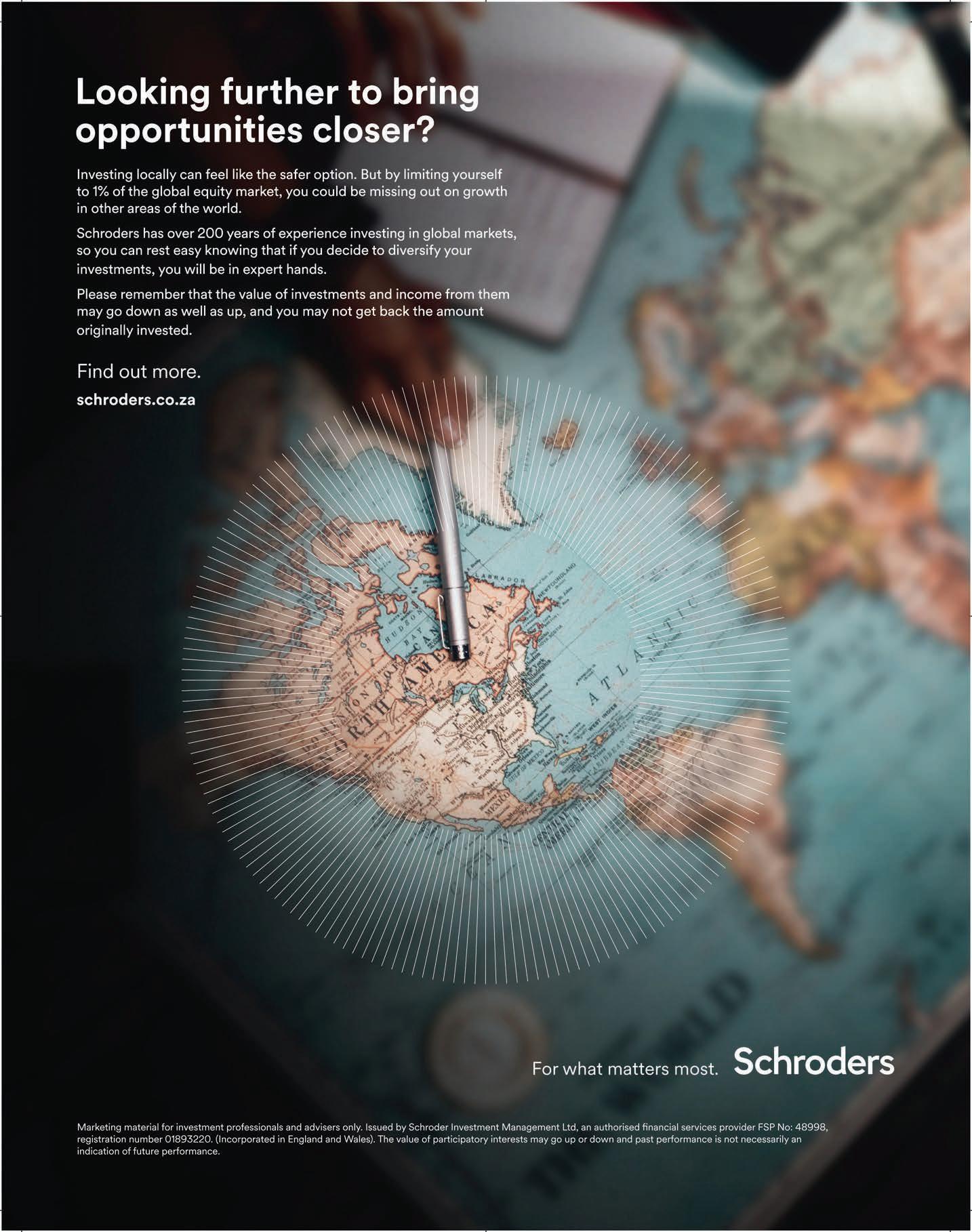
Small-scale Grower Project

Illovo’s small-scale grower project has signifi cantly impacted the development of cane growers and contributed to the advancement of the South African national agenda for job creation, rural economic development and transformation in agriculture
The end of 2020 marks the completion of the R126-million Illovo Small Scale Grower Cane Development Project that has created over 860 sustainable jobs on the south coast of KwaZulu-Natal, empowering rural women from this area to participate in the rural economy.
In 2017, Illovo Sugar South Africa (ISSA) signed an agreement with the National Treasury’s Jobs Fund to secure a R63-million grant to plant 3 000 hectares of sugarcane on communal land over three seasons and provide support to each cane grower. ISSA matched the funding to the value of R63-million. Since then, the Illovo Small Scale Grower Cane Development Project has made signifi cant strides and outperformed initial projections. The project used 119 local contractors, developed 1630 Growers fi elds to sugar cane, and increased the annual sustainable supply of sugarcane for its undersupplied Sezela factory by almost doubling the original 150 000 tonnes forecast.
The project has successfully created direct jobs in rural communities while implementing socioeconomic and enterprise development initiatives and the transfer of valuable farming and business skills. By leveraging on the built capabilities, communities will earn upwards of R64-million in income annually.
“We could not have achieved this level of success, which has contributed to the retention of our BBBEE Level 1 status, alone. The contributions of our industry partners, SA Canegrowers Association Mamongae Mahlare and SAFDA, have been integral to this multi-stakeholder project. However, it is the passion and entrepreneurial spirit of the people of the South Coast community that made it impossible to fail,” says Mamongae Mahlare, MD of Illovo Sugar South Africa.
Below are some of the stories that talk to ISSA’s purpose of building thriving communities.

MRS NGCOBO’s TRIUMPH
“I took over the sugarcane-growing role from my late husband. When Illovo Sugar reached out to our community with this project, my husband’s sugarcane that had been planted years before was no longer growing.
The project came at a crucial time for us because the eMalangeni area had run out of sugarcane and many growers were struggling. Sugarcane farming is our Mrs Ngcobo bread and butter – it allows us to pay for our children’s education. This has been a life-changing experience and we are so grateful to Illovo Sugar for empowering us and enriching our lives. “To be part of the cane grower’s community as a black woman makes me happy, especially having come from an impoverished background,” says Mrs Ngcobo, smallscale grower and current chairperson of Umgwempesi Cane Growers.
NOMVULA SHOZI’S PASSION
“Farming and agriculture have always interested me. I remember asking my father how sugarcane is grown and it remained a passion of mine. After fi nishing school and university studies, I moved to Durban to work.
“In early 2018, I learnt about the Illovo Small Scale Grower Development Project and decided to return and try my hand at Nomavula being a contractor and Shozi grower. The training provided changed all of our perspectives about growing sugarcane as a viable business. Illovo Sugar helped us put protocols in place to ensure the sustainability of our businesses. “This initiative also helped me to start and grow my own contracting business, which supports other growers by planting and ratooning their lands. With this project, everything has been kept local and the money we make goes back into our community. I love what I do and I am so grateful for the opportunity Illovo has given me to pursue my dreams,” says Nomvula Shozi, small-scale grower and contractor and young female entrepreneur from the eMalangeni region.
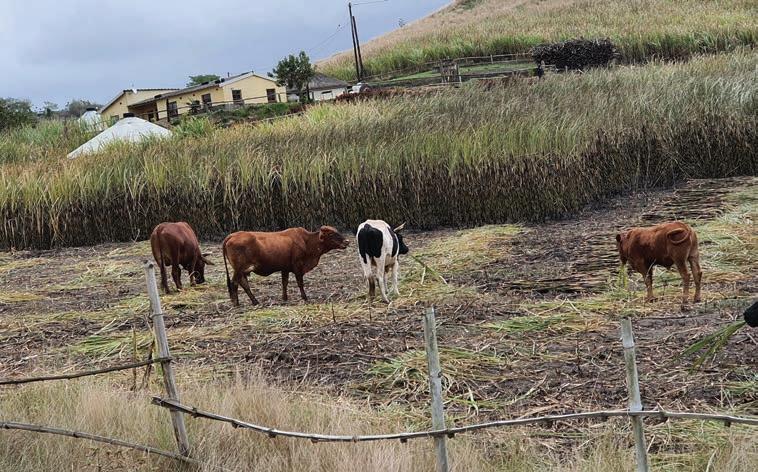
For more information: Connect with us on…
www.illovosugarafrica.com www.facebook.com/IllovoSugar










